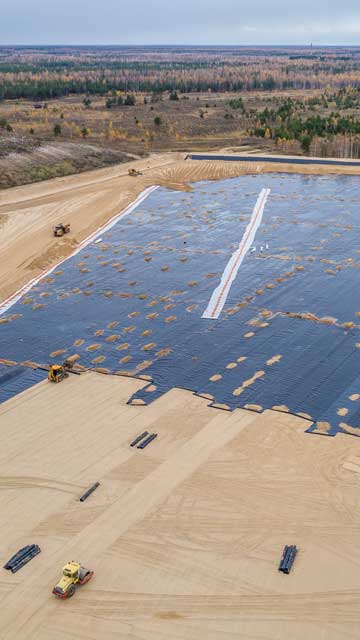Advocacy
PFAS in Landfills
PFAS enter landfills in a variety of ways:
- Municipal Solid Waste — In 2017 the US EPA estimated about 138 million tons of MSW is landfilled each year. We have established 10,000 PPT as representative of overall MSW PFAS content. Based on these figures, we estimate that about 2,755 lb. (1,250 kg) of PFAS chemicals go into US Landfills every year.
- Biosolids — Landfilling biosolids contributes between 1,030–1,295 lbs (470–590 kg) of PFAS per year.
- Cover Soils — PFAS input with cover soils is calculated to be 123.9 lbs (56.2 kg) per year.
- Precursors — A lack of analytical standards limits the quantification of perfluoroalkyl acids (PFAA) in precursor compounds.
- Precipitation — PFAS input from rainwater is calculated to be 1.35 lbs (0.61 kg/year) per year.
In total, we estimate the total PFAS inputs to landfills to be between 4,477–4,823 lbs (2,030.7–2,187.7 kg) per year.
While landfills might serve as long-term containment sites for PFAS, they have not been designed explicitly for PFAS containment. The largest landfill challenge is in keeping PFAS compounds out of landfill leachate.
How landfills sequester PFAS

Subtitle D Clay Liners
Single-layer clay liners (such as uncoated bentinite) may not be effective at sorbing PFAS chemicals.
Geosynthetic Landfill Covers
Geosynthetic Landfill Covers have been successful in keeping PFAS compounds from seeping into groundwater. Testing on LLDPE co-extruded with EVOH have found negligible source depletion, indicating limited contaminant partitioning and diffusion.
Further Reading
- Allred, et al., Physical and Biological Release of Poly- and Perfluoroalkyl Substances (PFASs) from Municipal Solid Waste in Anaerobic Model Landfill Reactors, Environ. Sci. Technol., 2015.
- Allred, et al., National Estimate of Per- and Polyfluoroalkyl Substance (PFAS) Release to US Municipal Landfill Leachate, Environ. Sci. Technol. 2017.
- Bridstrup, J., “Sorption of PFAS on Natural and Engineered Materials for Waste Containment”, Thesis Presented to the Faculty of the School of Engineering and Applied Science, University of Virginia, 2020
- Di Battista, et al., PFOA and PFOS diffusion through LLDPE and LLDPE coextruded with EVOH at 22° C, 35° C, and 50° C, Waste Management, 2020.
- Gates, et al., Interactions of Per-and Polyfluoralkyl Substances (PFAS) with Landfill Liners, Adv. Environ. Eng. Res., 2020.
- Hamid, et al., Review of the fate and transformation of per- and polyfluoroalkyl substances (PFASs) in landfills, Environ. Pollution, 2018.
- Sepulvado, et al., “Occurrence and Fate of Perfluorochemicals in Soil Following the Land Application of Municipal Biosolids”, Environ. Sci. Technol.. 2011.
- Venkatesan, et al., ”National inventory of perfluoroalkyl substances in archived US biosolids from the 2001 EPA National Sewage Sludge Survey”, Journal of Hazardous Materials, 2013.
Advertisement
Special Thanks
A special thank you to the Landfill Technical Division Landfill Leachate and Liquids Committee for providing up-to-date scientific and technical data about PFAS in solid waste.
Join Team/Contribute





